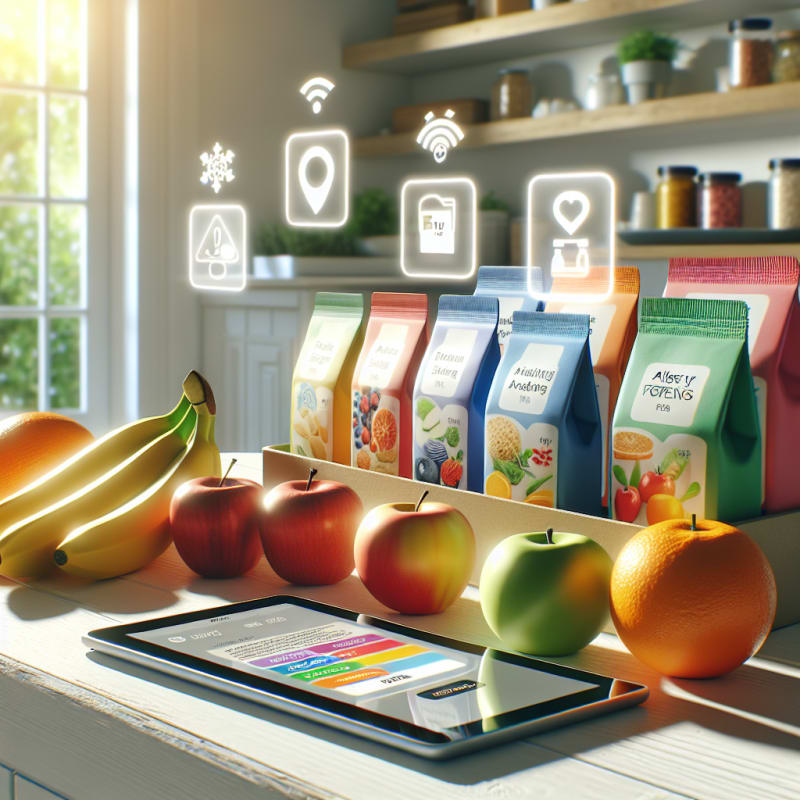How To Know If Food Contains Allergens?
Understanding what’s in your food is more important than ever. Whether you’re shopping for groceries, dining out, or preparing meals at home, the risk of hidden allergens is a growing concern for millions worldwide. In this comprehensive guide, we explore how to know if food contains allergens?—from reading labels to leveraging the latest technology—and why awareness is essential for everyone, not just those with allergies.
Why Allergen Awareness Matters
Food allergies affect approximately 10% of adults and 8% of children globally, according to recent research published in PubMed. The consequences of accidental exposure can be severe, ranging from mild discomfort to life-threatening anaphylaxis. Even for those without diagnosed allergies, understanding ingredients is crucial for dietary preferences, religious restrictions, and overall health.
- Consumer safety: Prevents accidental ingestion of allergens.
- Regulatory compliance: Food businesses are legally required to disclose major allergens (FDA).
- Empowerment: Enables informed choices for all dietary needs.
What Are Common Food Allergens?
The European Food Safety Authority (EFSA) and FDA recognize the following as the most prevalent food allergens:
| Allergen | Examples | Labeling Requirement |
|---|---|---|
| Milk | Cheese, yogurt, butter | Mandatory |
| Eggs | Mayonnaise, baked goods | Mandatory |
| Fish | Salmon, tuna, sauces | Mandatory |
| Crustacean shellfish | Shrimp, crab, lobster | Mandatory |
| Tree nuts | Almonds, walnuts, cashews | Mandatory |
| Peanuts | Snacks, spreads | Mandatory |
| Wheat | Bread, pasta, cereal | Mandatory |
| Soybeans | Tofu, soy sauce | Mandatory |
| Sesame | Hummus, tahini | Mandatory (US since 2023) |
How To Know If Food Contains Allergens? Step-by-Step Guide
1. Read Ingredient Labels Carefully
- Look for allergens listed in bold or highlighted text.
- Check for “may contain” or “produced in a facility” statements, which indicate possible cross-contact.
- Review ingredient lists for scientific or alternative names (e.g., casein for milk, albumin for egg).
2. Use Technology for Instant Answers
- Food Scan Genius: Apps like Food Scan Genius allow users to scan barcodes and instantly receive allergen information, ingredient breakdowns, and dietary compatibility.
- Online databases and manufacturer websites often provide detailed allergen data.
3. Ask Questions When Eating Out
- Speak with restaurant staff about ingredients and preparation methods.
- Request allergen-free options or modifications.
4. Stay Updated on Recalls and News
- Follow regulatory agencies for alerts on mislabeled products. For example, recent news from The New York Times highlights ongoing challenges with food labeling accuracy.
- Set alerts for major recalls via FDA or EFSA websites.
Challenges in Allergen Detection
Despite regulations, hidden allergens remain a risk due to:
- Cross-contamination: Shared equipment or facilities can introduce trace allergens.
- Ambiguous labeling: Vague ingredient names or incomplete disclosures.
- Imported foods: Different countries have varying labeling standards (BBC News).
Recent studies show that up to 20% of allergen incidents are due to labeling errors or cross-contact (PubMed).
How Technology Is Transforming Allergen Awareness
Modern solutions are making it easier than ever to identify allergens:
- Barcode scanning apps instantly decode ingredient lists and flag allergens.
- AI-powered platforms analyze recipes, restaurant menus, and packaged foods for hidden risks.
- Wearable devices (in development) may soon detect allergen molecules in real time.
For example, Food Scan Genius uses AI and crowd-sourced data to provide up-to-date allergen alerts, ingredient translations, and compatibility scores for various diets. As one user, Sarah L., shared:
“Food Scan Genius has changed the way I shop. I can scan any product and instantly see if it’s safe for my peanut allergy. It even tells me about cross-contact risks. I recommend it to anyone with food sensitivities!”
Try Food Scan Genius
Q&A: Key Questions About Food Allergens
Q: What are the most common symptoms of a food allergy?
A: Symptoms may include hives, swelling, difficulty breathing, nausea, or anaphylaxis. If you suspect an allergy, consult a healthcare professional immediately (FDA).
Q: Can “may contain” statements be ignored?
A: No. “May contain” warnings indicate a real risk of cross-contact. Avoid products if you have a severe allergy.
Q: Are natural or organic foods safer for people with allergies?
A: Not necessarily. Allergens can be present in both conventional and organic foods. Always check labels and ask questions.
Q: How accurate are barcode scanning apps?
A: Leading apps like Food Scan Genius use verified databases and user feedback, but always double-check with official sources for critical allergies.
Q: What should I do if I suspect a mislabeled product?
A: Report it to regulatory authorities (FDA, EFSA) and avoid consumption. Recent news from CNN Health underscores the importance of vigilance.
Global Trends in Allergen Disclosure
Governments and industry leaders are taking steps to improve transparency:
- Expanded labeling laws: The US now requires sesame disclosure; EU mandates clear allergen formatting.
- Digital traceability: Blockchain and AI are being piloted for supply chain transparency.
- Consumer advocacy: Groups push for stricter enforcement and better education.
Recent coverage in The New York Times highlights both progress and persistent gaps in allergen labeling.
Who Should Care About Allergen Awareness?
- Individuals with allergies: For safety and peace of mind.
- Parents and caregivers: Protecting children from accidental exposure.
- Food businesses: Legal compliance and customer trust.
- Health-conscious consumers: Understanding additives, preservatives, and hidden ingredients.
- Religious and ethical eaters: Ensuring food meets dietary requirements.
Allergen awareness is not just a medical issue—it’s a social, economic, and ethical concern that touches everyone.
Related Issues: Beyond Allergens
Ingredient transparency also relates to:
- Food intolerances: Lactose, gluten, and other non-allergic sensitivities.
- Dietary preferences: Vegan, vegetarian, kosher, halal, and low-FODMAP diets.
- Environmental concerns: Traceability for sustainable sourcing.
- Food fraud: Mislabeling and adulteration risks.
As consumer expectations rise, technology and regulation must evolve to meet the demand for clear, accurate ingredient information.
How to Stay Safe: Practical Tips
- Always read labels—even for familiar products.
- Use trusted apps like Food Scan Genius for instant allergen checks.
- Ask questions at restaurants and food counters.
- Monitor news and recalls for updates on food safety.
- Educate family and friends about allergen risks.
Conclusion: Empowering Safer Choices
In a world of complex ingredient lists and evolving food technology, knowing how to know if food contains allergens? is essential for everyone. By combining careful label reading, proactive questioning, and smart tools like Food Scan Genius, you can confidently navigate food choices—protecting your health and supporting broader transparency. The journey toward safer, more informed eating begins with awareness and the right resources.
Ready to take control? Download Food Scan Genius today and join a community committed to safe, informed eating.
References
- FDA: Food Allergens & Labeling
- EFSA: Food Allergens
- PubMed: Prevalence of Food Allergies
- The New York Times: Food Allergy Labels
- BBC News: Food Labeling Standards
- CNN Health: Food Allergy Labeling
Frequently Asked Questions
A: Use barcode scanning apps like Food Scan Genius or read the ingredient label for bolded allergens.
A: Not always, but they indicate potential cross-contact and should be taken seriously.
A: Subscribe to FDA or EFSA recall alerts and monitor news sources.
A: Yes, it supports multiple regions and languages. Learn more.
{
“@context”: “https://schema.org”,
“@type”: “FAQPage”,
“mainEntity”: [
{
“@type”: “Question”,
“name”: “What is the fastest way to check for allergens in packaged food?”,
“acceptedAnswer”: {
“@type”: “Answer”,
“text”: “Use barcode scanning apps like Food Scan Genius or read the ingredient label for bolded allergens.”
}
},
{
“@type”: “Question”,
“name”: “Are “may contain” warnings legally required?”,
“acceptedAnswer”: {
“@type”: “Answer”,
“text”: “Not always, but they indicate potential cross-contact and should be taken seriously.”
}
},
{
“@type”: “Question”,
“name”: “How can I stay updated on allergen recalls?”,
“acceptedAnswer”: {
“@type”: “Answer”,
“text”: “Subscribe to FDA or EFSA recall alerts and monitor news sources.”
}
},
{
“@type”: “Question”,
“name”: “Is Food Scan Genius available internationally?”,
“acceptedAnswer”: {
“@type”: “Answer”,
“text”: “Yes, it supports multiple regions and languages. Visit scangeni.us to learn more.”
}
}
]
}





